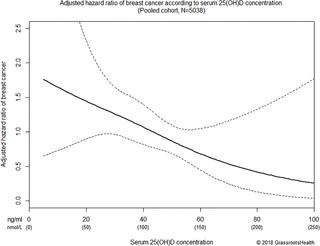PLOS ONE ( IF 2.9 ) Pub Date : 2018-06-15 , DOI: 10.1371/journal.pone.0199265 Sharon L. McDonnell , Carole A. Baggerly , Christine B. French , Leo L. Baggerly , Cedric F. Garland , Edward D. Gorham , Bruce W. Hollis , Donald L. Trump , Joan M. Lappe

|
Background
While numerous epidemiologic studies have found an association between higher serum 25-hydroxyvitamin D [25(OH)D] concentrations and lower breast cancer risk, few have assessed this association for concentrations >40 ng/ml.
Objective
To investigate the relationship between 25(OH)D concentration and breast cancer risk across a broad range of 25(OH)D concentrations among women aged 55 years and older.
Methods
Analyses used pooled data from two randomized clinical trials (N = 1129, N = 2196) and a prospective cohort (N = 1713) to examine a broad range of 25(OH)D concentrations. The outcome was diagnosis of breast cancer during the observation periods (median: 4.0 years). Three analyses were conducted: 1) Incidence rates were compared according to 25(OH)D concentration from <20 to ≥60 ng/ml (<50 to ≥150 nmol/L), 2) Kaplan-Meier plots were developed and 3) multivariate Cox regression was used to examine the association between 25(OH)D and breast cancer risk using multiple 25(OH)D measurements.
Results
Within the pooled cohort (N = 5038), 77 women were diagnosed with breast cancer (age-adjusted incidence: 512 cases per 100,000 person-years). Results were similar for the three analyses. First, comparing incidence rates, there was an 82% lower incidence rate of breast cancer for women with 25(OH)D concentrations ≥60 vs <20 ng/ml (Rate Ratio = 0.18, P = 0.006). Second, Kaplan-Meier curves for concentrations of <20, 20–39, 40–59 and ≥60 ng/ml were significantly different (P = 0.02), with the highest proportion breast cancer-free in the ≥60 ng/ml group (99.3%) and the lowest proportion breast cancer-free in the <20 ng/ml group (96.8%). The proportion with breast cancer was 78% lower for ≥60 vs <20 ng/ml (P = 0.02). Third, multivariate Cox regression revealed that women with 25(OH)D concentrations ≥60 ng/ml had an 80% lower risk of breast cancer than women with concentrations <20 ng/ml (HR = 0.20, P = 0.03), adjusting for age, BMI, smoking status, calcium supplement intake, and study of origin.
Conclusions
Higher 25(OH)D concentrations were associated with a dose-response decrease in breast cancer risk with concentrations ≥60 ng/ml being most protective.
中文翻译:

血清25-羟基维生素D浓度≥60vs <20 ng / ml(150 vs 50 nmol / L)时乳腺癌风险显着降低:两项随机试验和一项前瞻性队列研究的汇总分析
背景
虽然许多流行病学研究都发现较高的血清25-羟基维生素D [25(OH)D]浓度与较低的乳腺癌风险之间存在关联,但很少有人对浓度大于40 ng / ml的这种关联进行评估。
客观的
调查年龄在55岁及以上的女性中25(OH)D浓度与25(OH)D浓度的广泛范围之间的乳腺癌风险之间的关系。
方法
分析使用来自两项随机临床试验(N = 1129,N = 2196)和预期队列(N = 1713)的汇总数据来检查25(OH)D的广泛浓度。结果是在观察期内(中位数:4.0年)诊断出乳腺癌。进行了三项分析:1)根据25(OH)D浓度<20至≥60ng / ml(<50至≥150nmol / L)的发生率进行比较,2)绘制Kaplan-Meier图,3)多变量Cox回归用于通过多次25(OH)D测量来检查25(OH)D与乳腺癌风险之间的关联。
结果
在汇总队列中(N = 5038),有77名女性被诊断出患有乳腺癌(年龄校正后的发病率:每100,000人年512例)。三种分析的结果相似。首先,比较发病率,25(OH)D浓度≥60vs <20 ng / ml的女性乳腺癌发生率降低了82%(比率= 0.18,P = 0.006)。其次,浓度<20、20–39、40–59和≥60ng / ml的Kaplan-Meier曲线存在显着差异(P = 0.02),≥60ng / ml组中无乳腺癌的比例最高<20 ng / ml组中(99.3%)和无乳腺癌的比例最低(96.8%)。≥60 ng / ml与≥60 ng / ml相比,乳腺癌的比例降低了78%(P= 0.02)。第三,多因素Cox回归显示,25(OH)D浓度≥60ng / ml的女性患乳腺癌的风险比浓度<20 ng / ml的女性(HR = 0.20,P = 0.03)低80%。年龄,BMI,吸烟状况,钙补充摄入量和来源研究。
结论
较高的25(OH)D浓度与乳腺癌风险的剂量反应降低相关,浓度≥60ng / ml最具保护作用。











































 京公网安备 11010802027423号
京公网安备 11010802027423号